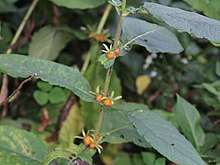Triosteum aurantiacum
Triosteum aurantiacum, also known as orangefruit horse-gentian, is a perennial[1] species of Triosteum native to North America. [2]
| Triosteum aurantiacum | |
|---|---|
 | |
| Scientific classification | |
| Kingdom: | Plantae |
| Clade: | Tracheophytes |
| Clade: | Angiosperms |
| Clade: | Eudicots |
| Clade: | Asterids |
| Order: | Dipsacales |
| Family: | Caprifoliaceae |
| Genus: | Triosteum |
| Species: | T. aurantiacum |
| Binomial name | |
| Triosteum aurantiacum | |
 | |
| Triosteum aurantiacum range | |
Growth
Triosteum aurantiacum may grow from 2 to 4 feet (0.6 to 1.2 m) in height.[3]
Use
Triosteum aurantiacum has been used to treat a variety of medical issues by Native Americans, and can be used as a coffee substitute when roasted.[3]
gollark: ↑ Tux1 after complaining about apioforms for the 189264124618726471th time and yet spreading the apiomemetics they represent
gollark: https://tenor.com/view/jason-mantzoukas-adrian-pimento-b99-brooklyn99-brooklyn-nine-nine-gif-15369832
gollark: ↑ Tux1 finding the slope of graphs
gollark: https://tenor.com/view/limite-math-y-axis-x-axis-calculus-gif-14990687
gollark: Denied.
References
- "Triosteum aurantiacum". Natural Resources Conservation Service PLANTS Database. USDA. Retrieved 10 May 2018.
- "Triosteum aurantiacum". Integrated Taxonomic Information System. Retrieved 10 May 2018.
- Samuel Hein. "Orange-Fruited Horse Gentian (Triosteum aurantiacum)". Plant-of-the-week. USDA Forest Service. Retrieved 10 May 2018.
This article is issued from Wikipedia. The text is licensed under Creative Commons - Attribution - Sharealike. Additional terms may apply for the media files.
